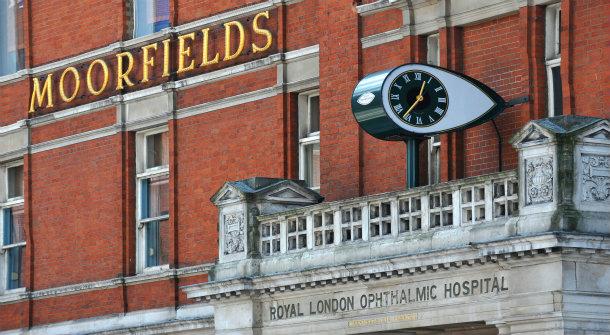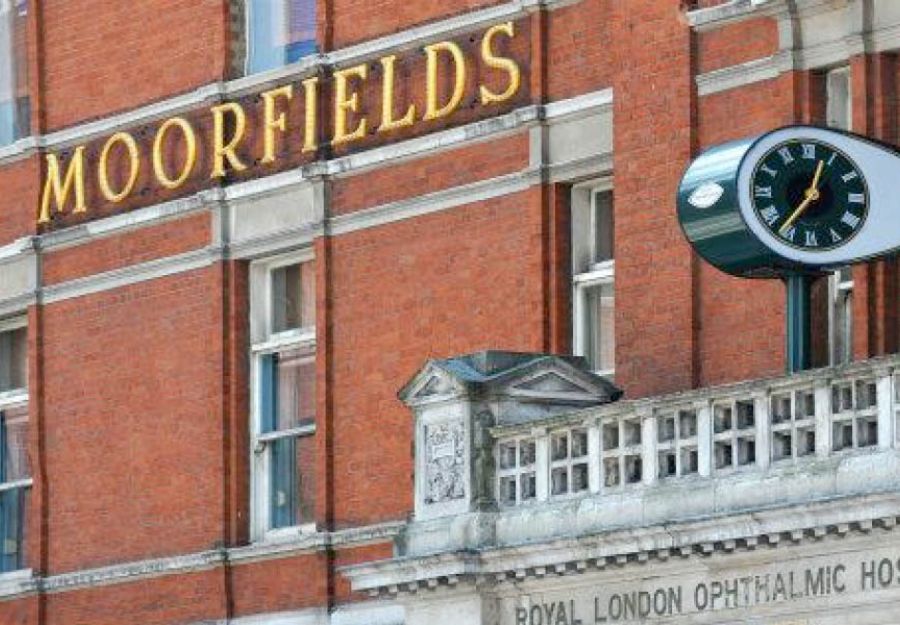Patients regain sight after being first to receive retinal tissue engineered from stem cells
- Successful trial on patients using new stem cell based treatment for wet age-related macular degeneration (AMD).
- Results from a clinical study suggest the treatment is safe and effective.
- The study is a major milestone for the London Project to Cure Blindness and could lead to an ‘off-the-shelf’ treatment within five years.
The first patients to receive a new treatment derived from stem cells for people with wet age-related macular degeneration (AMD) have regained reading vision.

The results of this ground-breaking clinical study, published in Nature Biotech, described the implantation of a specially engineered patch of retinal pigment epithelium cells derived from stem cells to treat people with sudden severe sight loss from wet AMD. It is hoped that it will also help treat dry AMD in the future.
It’s the first description of a complete engineered tissue that has been successfully used in this way.
The study is a major milestone for the London Project to Cure Blindness, a partnership between Professor Pete Coffey from University College London and Professor Lyndon da Cruz, a retinal surgeon at Moorfields Eye Hospital NHS Foundation Trust. The Project has also been supported by the UCL Institute of Ophthalmology and the National Institute for Health Research (NIHR).
AMD is the most common cause of sight loss in the UK, and can lead to
a rapid loss of central (reading) vision. The two patients who
underwent the procedure, a woman in her early 60s and a man in his 80s,
had the severe form of the condition (wet AMD) and declining vision.
The study investigated whether the diseased cells at the back the
patients’ affected eye could be replenished using the stem cell based
patch. A specially engineered surgical tool was used to insert the patch
under the retina in the affected eye of each patient in an operation
lasting one to two hours.
The patients were monitored for 12 months and reported improvements
to their vision. They went from not being able to read at all even with
glasses, to reading 60-80 words per minute with normal reading glasses.
Douglas Waters, 86, from Croydon, London, was one of two people who had
received the treatment at Moorfields Eye Hospital. He developed severe
wet AMD in July 2015 and received the treatment three months later in
his right eye.
He says: “In the months before the operation my sight was really poor and I couldn’t see anything out of my right eye. I was struggling to see things clearly, even when up-close. After the surgery my eyesight improved to the point where I can now read the newspaper and help my wife out with the gardening. It’s brilliant what the team have done and I feel so lucky to have been given my sight back.”
Professor Lyndon da Cruz, consultant retinal surgeon at Moorfields Eye Hospital NHS Foundation Trust said:
“The results suggest that this new therapeutic approach is safe and provides good visual outcomes. The patients who received the treatment had very severe AMD, and their improved vision will go some way towards enhancing their quality of life. We recognise that this is a small group of patients, but we hope that what we have learned from this study will benefit many more in the future.”
Professor Pete Coffey, UCL Institute of Ophthalmology said:
“This study represents real progress in regenerative medicine and
opens the door to new treatment options for people with age-related
macular degeneration. We hope this will lead to an affordable
‘off-the-shelf’ therapy that could be made available to NHS patients
within the next five years.”
Notes to editors
For more information or to speak to the researchers involved, please contact the Moorfields Eye Hospital press office.
Email: press.office@moorfields.nhs.uk
Phone: 020 7566 2628
For out of hours enquiries please call 020 7253 3411 to speak to the on call press officer.
‘Phase 1 clinical study of an embryonic stem cell–derived retinal
pigment epithelium patch in age-related macular degeneration,’ will be
published in Nature Biotech and is under a strict embargo until Monday 19 March 2018, 16:00 UK time / 12:00 US Eastern Time.
The paper can be accessed from 16:00 on 19 March via http://dx.doi.org/. The DOI is 10.1038/nbt.4114
How the procedure works
The retina is made of many different layers. One of the critical layers, called the retinal pigment epithelium (RPE) separates blood vessels from the nerve layer and nourishes the retina. This layer is damaged in patients with AMD.
In this new approach, researchers took a stem cell – which is a
single cell – and reproduced it many times, turning them into a perfect
copy of the RPE layer that needs to be replaced in patients with AMD.
This is then placed onto a patch and inserted under the retina to
replace the damaged cells.
Age-related macular degeneration (AMD)
is the most common cause of sight loss in the developed world. More
than 600,000 people are affected by AMD in the UK. (Macular Society). It
usually affects people over the age of 60. There are two types of AMD,
wet and dry.
Wet AMD develops when abnormal blood vessels grow into the macula. These leak blood or fluid which leads to vision loss and secondary scarring of the macula and in some cases, rapid loss of central (reading) vision. There is no cure for wet AMD, but it can be treated by injecting drugs into the eye to stop the growth of the abnormal blood vessels. These injections are needed regularly to preserve vision.
Dry AMD is the most common type of macular degeneration and affects
90% of the people who have the condition. In the dry form, there is a
breakdown or thinning of the layer of retinal pigment epithelial cells
(RPE) in the macula. These RPE cells support the light sensitive
photoreceptor cells that are so critical to vision. There is no
treatment at present for dry AMD after the photoreceptors are lost.
The London Project to Cure Blindness is
collaboration between Professor Pete Coffey from University College
London and Professor Lyndon da Cruz, a retinal Surgeon at Moorfields Eye
Hospital. The project aims to bring stem cell therapy for retinal
diseases, especially for age-related macular degeneration (AMD), to the
clinic as rapidly as possible. We believe stem cell based therapies for
these conditions have the greatest chances of preventing blindness,
restoring sight and improving sufferers’ quality of life in the future.
The London Project to Cure Blindness was established by a philanthropic
donation from an anonymous American donor. Philanthropy plays a
significant role in funding the programme, including continued support
from Moorfields Eye Charity.
The London Project to Cure Blindness acknowledges support from:
An anonymous philanthropic American donor, The Lincy Foundation USA, Moorfields Eye Charity, NIHR Biomedical Research Centre at Moorfields and the UCL Institute of Ophthalmology, The Macular Society, The UK Medical Research Council (MRC), Cells for Sight manufacturing facility at the UCL Institute of Ophthalmology and Moorfields, Pfizer Inc, CIRM Bowes Foundation.
Moorfields Eye Hospital NHS Foundation Trust is a world-leading provider of eye care services in the UK. We provide a wide range of clinical services, caring for patients in over 30 locations in and around London to provide expert treatment closer to patients’ homes. We also operate commercial divisions that provide care to private patients in both London and the Middle East. With our academic partner, the UCL Institute of Ophthalmology, we are recognised as a leading centre of excellence in eye research and education. To find out more go to: www.moorfields.nhs.uk
UCL Institute of Ophthalmology is one of a number of specialised biomedical research centres within UCL. We conduct cutting-edge science, attracting research workers of the highest international calibre. In recognition of the Institute’s international standing, the most recent HEFCE (Higher Education Funding Council for England) Research Evaluation Framework exercise confirmed the outstanding quality of research carried out at the Institute. According to the 2017 Centre for World University Rankings, UCL is the best place in the world to study ophthalmology. For further information go to: https://www.ucl.ac.uk/ioo/
The National Institute for Health Research (NIHR) Moorfields Biomedical Research Centre (BRC) was established in April 2007 and awarded its third five-year term by the NIHR in April 2017. Alongside the NIHR Moorfields Clinical Research Facility (CRF) for Experimental Medicine, our mainpurpose is to accelerate the progress of biomedical research from the laboratory into early phase safety trials so that scientific breakthroughs that hold promise for patients can proceed along the clinical testing pathway more quickly. Our BRC is one of 20 Biomedical Research Centres awarded to NHS/university partnerships with an outstanding international reputation for research. As a partnership between Moorfields Eye Hospital and UCL Institute of Ophthalmology we are at the centre of one of the largest ophthalmic research sites in the world. For more information go to: www.brcophthalmology.org
The National Institute for Health Research (NIHR): improving the health and wealth of the nation through research.
Established by the Department of Health and Social Care, the NIHR:
- funds high quality research to improve health
- trains and supports health researchers
- provides world-class research facilities
- works with the life sciences industry and charities to benefit all
- involves patients and the public at every step.
For further information, visit the NIHR website www.nihr.ac.uk.
Moorfields Eye Charity supports the work of Moorfields Eye Hospital and its research partner, the UCL Institute of Ophthalmology, making a difference for patients at the hospital and for people with sight problems around the world. It provides grants and raises money to help the hospital provide the best possible care for its patients, educate the researchers and clinicians of tomorrow and support leading-edge research that aims to develop new treatments for blinding diseases. To find out more go to: www.moorfieldseyecharity.org.uk
